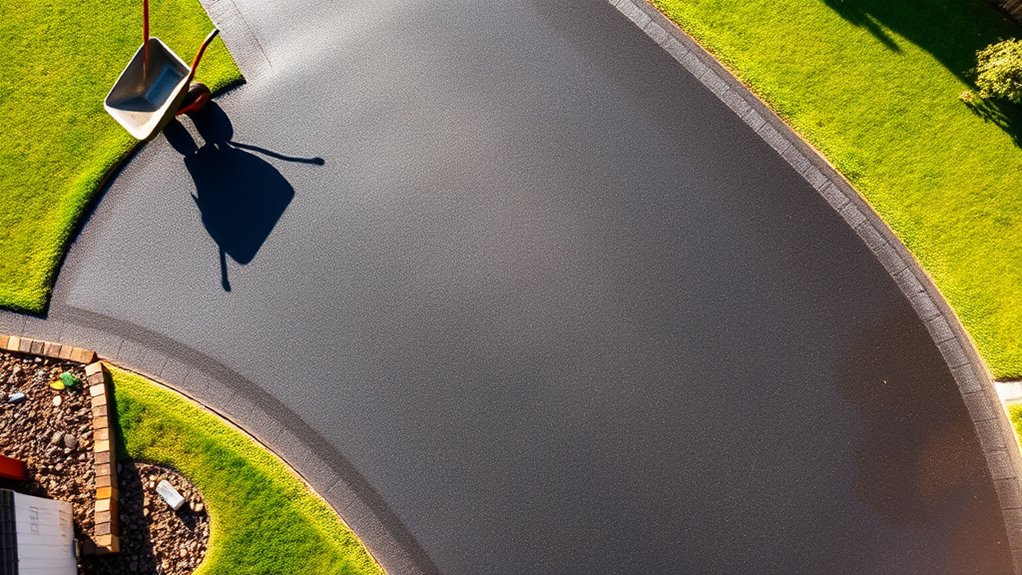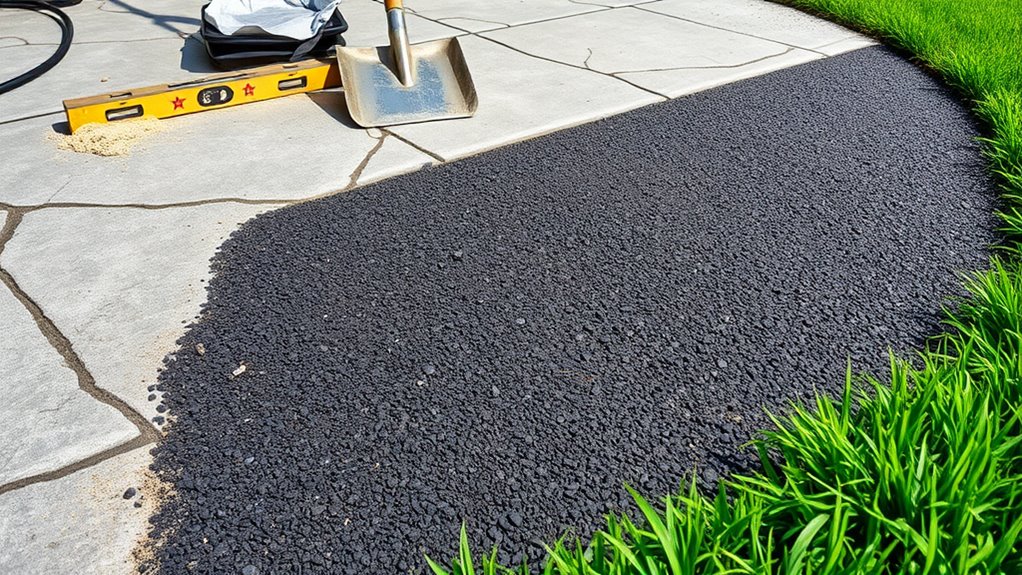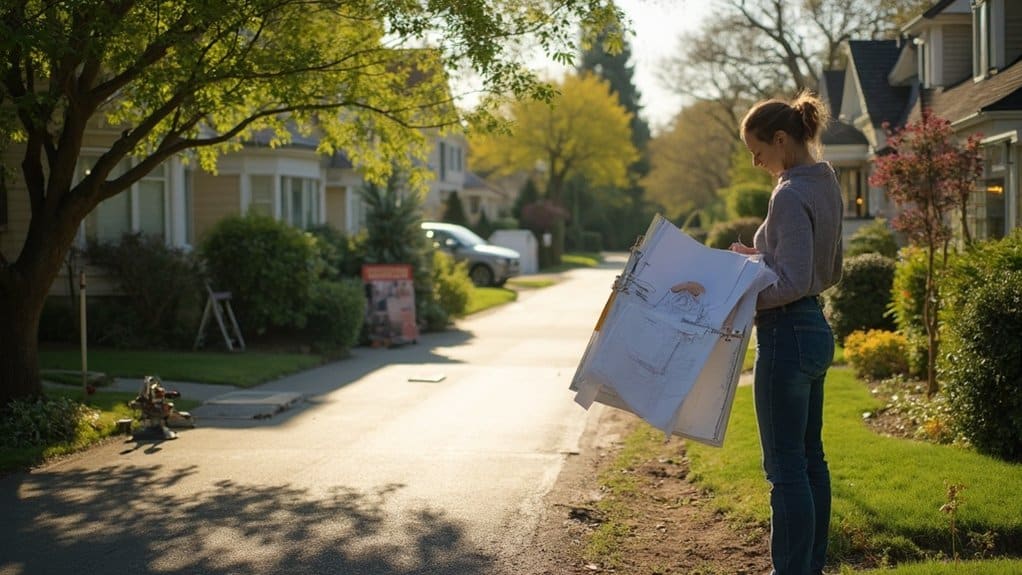Yes, you can apply for retrospective planning permission for a driveway in the UK. This involves submitting an application to your local planning authority, which will assess the impact on neighbours and ensure compliance with planning policies. It’s important to note that you have four years to rectify any unauthorised work, so time is of the essence. You’ll need to provide proper evidence and documentation for your application to be successful. If you’re unsure about the specific requirements or potential risks involved, it’s worth doing a bit more research.
Table of Contents
ToggleKey Takeaways
Yes, you can apply for retrospective planning permission for a driveway if you’ve done work without prior consent. You’ll need to submit your application to the local planning authority, which will assess it for compliance.
When applying, it’s essential to provide evidence such as site plans, photographs, and drainage details to strengthen your case. Keep in mind that retrospective permission can be refused, which may result in enforcement action or fines for the unauthorised work.
To avoid any complications, it’s wise to check with your local council before starting any driveway projects to ensure you’re following the rules.
Understanding Retrospective Planning Permission
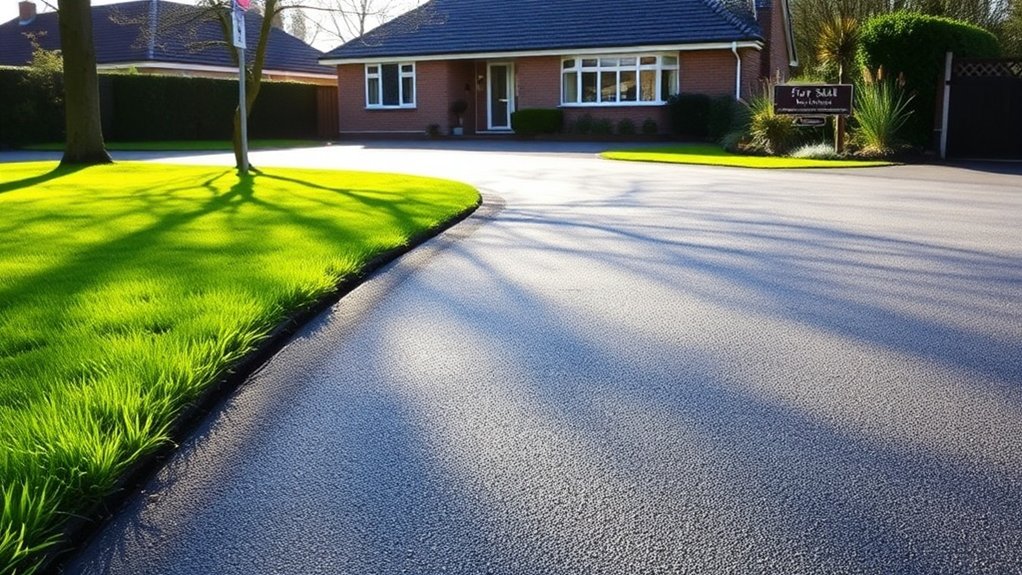
Understanding retrospective planning permission is crucial if you’ve carried out building work without prior approval. This process involves applying for formal consent for alterations already made, addressing any issues that may arise from unauthorised changes. You’ll need to submit an application to your local planning authority, which will assess it against relevant policies and consider the impact on your neighbours. Additionally, securing planning permission for a driveway constructed without prior consent may require demonstrating compliance with local regulations. Be prepared for the possibility that your application might be refused. This can lead to enforcement action, which may require you to modify or remove the work. It’s a riskier option; while successful approval will legitimise your project, a refusal could lead to fines or legal complications. Navigating this process carefully is essential to protect your interests, especially for projects like driveway developments.
Legal Time Limits for Retrospective Applications

If you’ve carried out building work without obtaining prior approval, it’s crucial to understand the legal time limits for retrospective planning applications.
According to the Town and Country Planning Act 1990, you generally have four years to rectify building works and ten years for changes of use. Once these periods elapse, enforcement action can’t be taken against you, providing some immunity from penalties, although this doesn’t grant you formal planning permission. However, if you’ve hidden any unauthorised works, the time limits reset, and ongoing breaches can affect the ten-year rule. Additionally, applying for retrospective planning permission can help address issues related to retrospective planning compliance and reduce potential enforcement risks.
To ensure legal clarity, it may be wise to apply for a lawful development certificate once the time frames have lapsed.
Be mindful of your specific situation and its legal implications when considering your next steps.
When Planning Permission Is Required for Driveways

When planning to create a driveway, understanding when you need planning permission is essential to avoid potential issues. Typically, you’ll need permission if you’re creating a new access point to a public road or significantly widening an existing driveway that impacts boundaries or nearby properties. For instance, if you’re adding a new entrance from a public road, you must seek permission. If your driveway is made from non-porous materials and covers more than 5m², you’ll also need planning permission unless the rainwater can drain into a permeable area. Furthermore, if you live in a conservation area or under Article 4 directions, any changes to your driveway may require permission. Always check with your local planning authority to ensure you comply with all relevant access requirements and regulations specific to your property, as planning permission is crucial for maintaining orderly development in your area. Additionally, it is important to remember that permitted development rights can sometimes allow for certain driveway modifications without full planning permission.
Risks of Unauthorized Driveway Works

Unauthorized driveway works can lead to serious legal and financial risks for homeowners. Here’s what you should consider:
- Legal Fines: You risk fines of up to £1,000 for unauthorised works, such as driving over kerbs without the necessary crossovers.
- Vehicle Damage: Crossing undropped kerbs can harm your vehicle, with 54% of drivers reporting damage from such incidents.
- Safety Hazards: Making unsanctioned changes can create safety risks, much like an unregulated building site.
- Neighbourhood Disputes: These works can create tensions in the community, particularly if they obstruct access or cause disturbances for neighbours.
Neglecting these risks might lead to enforcement actions and expensive fixes, so it’s crucial to approach any driveway alterations with care.
The Process of Applying for Retrospective Permission
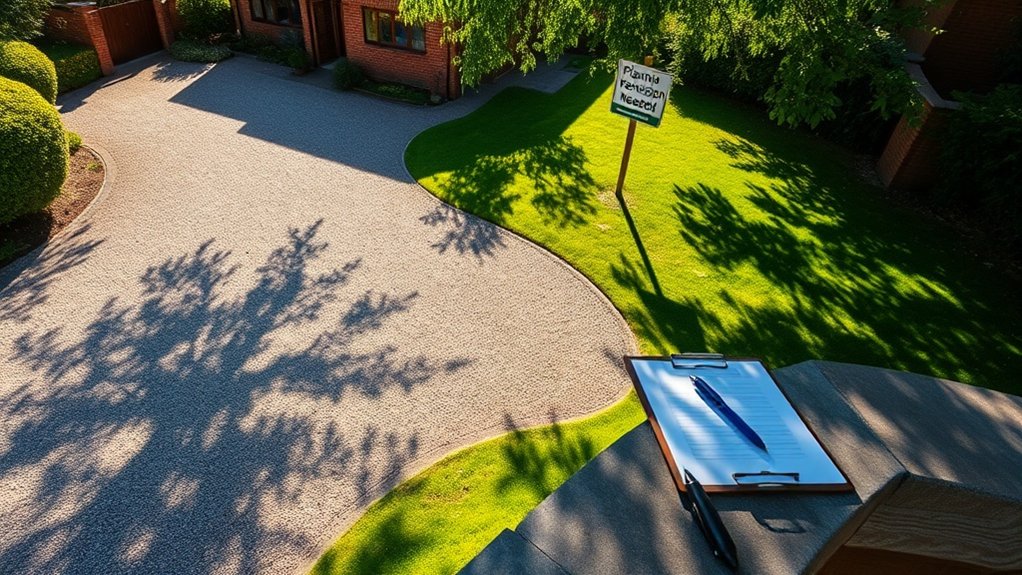
Applying for retrospective permission involves a few straightforward steps, beginning with a full application that follows standard procedures.
You’ll need to gather substantial evidence, such as photographs and site plans, to support your case and show that you comply with planning policies.
For instance, if you’ve built a garden shed without permission, including clear photos and a detailed site plan can strengthen your application.
Understanding these requirements is crucial for navigating the application process smoothly.
Application Submission Steps
Before starting the application submission process for retrospective planning permission for your driveway, it’s important to ensure that your project complies with local regulations.
Here’s a straightforward guide to help you through the application process:
- Preparation: Check if you need planning permission for your driveway. Gather all necessary details, such as the materials you’ll use and the dimensions of your driveway.
- Documentation: Fill out the planning application form. Include scaled drawings and any supporting documents that show how your project meets local policies.
- Submission: Send your application to the local planning authority, making sure to follow their guidelines and include the correct fee.
- Confirmation: Ask for a receipt and reference number to keep track of your application. Be ready for possible requests for additional information during the review.
Following these steps will make your submission process smoother.
Evidence for Approval
When applying for retrospective planning permission for your driveway, it’s crucial to provide solid evidence showing that you comply with local planning policies.
Start with detailed “before and after” architectural drawings to demonstrate the driveway’s visual impact and aesthetic appeal. You’ll also need a planning or design and access statement that explains how your driveway adheres to regulations regarding size, materials, and drainage.
Don’t forget to include photographs of the completed work and any relevant documents that prove your planning compliance.
Remember, it’s your responsibility to provide this proof; failing to do so could result in enforcement action.
If your driveway has been in place for over four years, you might want to apply for a Certificate of Lawfulness, which requires evidence of continuous use and that authorities weren’t aware of the situation.
Evidence and Documentation Needed for Approval
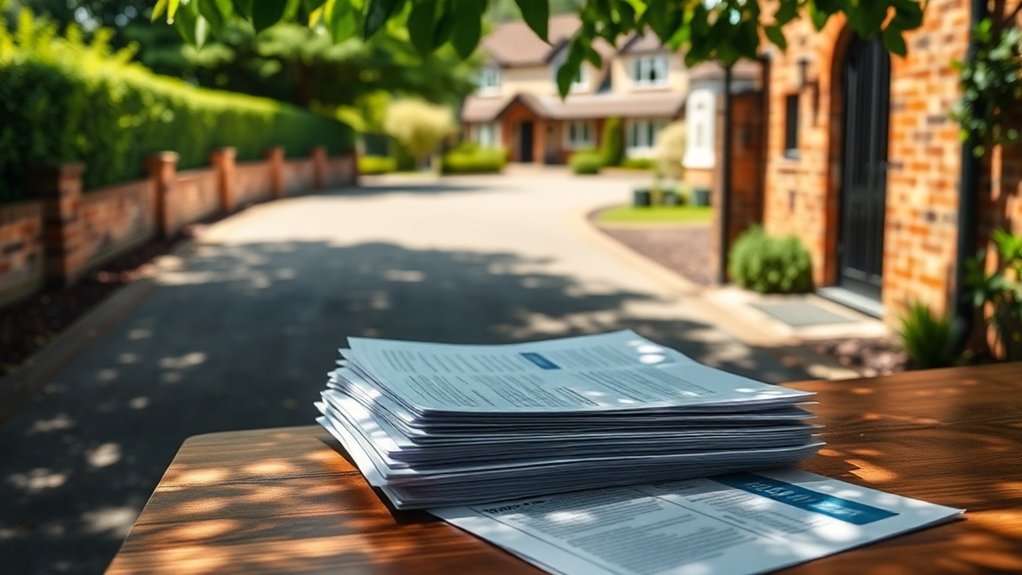
To obtain retrospective planning permission for your driveway, it’s essential to compile a comprehensive set of evidence and documentation to demonstrate compliance with local regulations.
Here are four key items to prepare:
- As-built plans: Clear drawings that show the layout, dimensions, and materials of your driveway.
- Photographic evidence: Recent, clear photos taken from various angles, showing how the driveway relates to your property and the public road.
- Drainage details: Documentation that confirms you have adhered to local regulations, such as using permeable materials.
- Professional reports: Assessments from engineers or architects that verify your compliance with planning authorities.
Having these documents ready will support your application and enhance your chances of securing retrospective permission.
Preventative Measures to Avoid Retrospective Issues
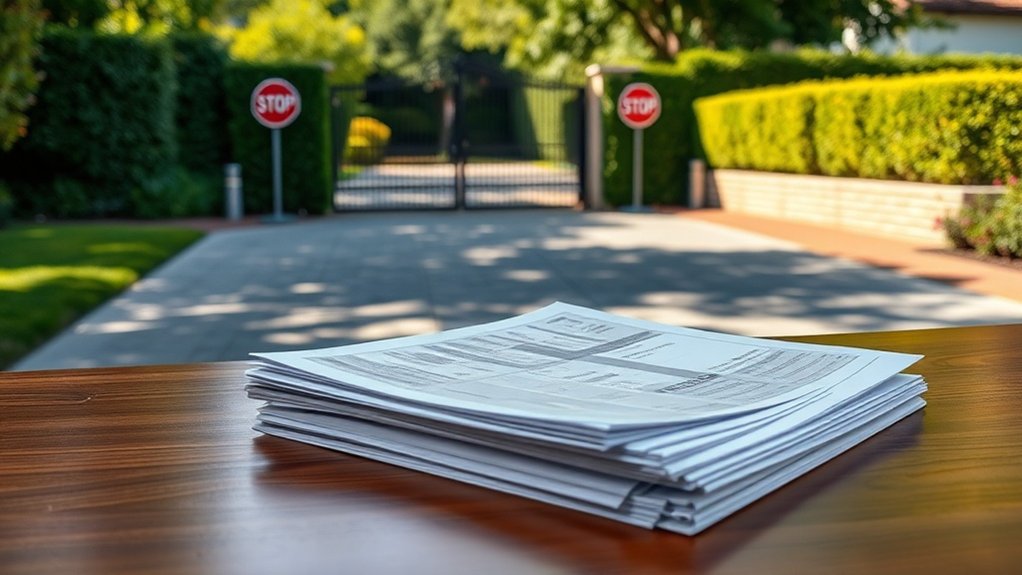
To prevent retrospective planning issues, use permeable materials for your driveway and ensure you have all necessary permissions. This approach not only meets drainage regulations but also reduces the likelihood of future complications. Check with local authorities and be aware of your property’s specific restrictions to protect your project from any enforcement actions later on. Additionally, implementing Sustainable Drainage Systems (SuDS) can further enhance your driveway’s compliance and effectiveness in managing stormwater.
Use Permeable Materials
Using permeable materials for your driveway not only boosts its appearance but also helps you avoid potential planning issues.
Opting for these materials offers several benefits while being kind to the environment:
- Stormwater Management: Water seeps into the ground, reducing runoff and the risk of flooding.
- Pollution Filtration: Filters out pollutants before they reach waterways, enhancing water quality.
- Ecosystem Support: Aids in groundwater recharge, benefiting local plants and wildlife.
- Urban Heat Reduction: Helps lower the urban heat island effect compared to standard surfaces.
Additionally, permeable driveways contribute to groundwater recharge by allowing rainwater to replenish aquifers naturally.
Choosing permeable options is a smart move for your property and the planet.
Obtain Necessary Permissions
Obtaining the necessary permissions before building your driveway is crucial to avoid issues with retrospective planning permission.
Start with a thorough planning appraisal to identify any restrictions or consents needed. If your project doesn’t qualify under Permitted Development Rights (PDR), you’ll need to submit a formal planning application, including all required documentation and drainage plans.
If your driveway connects to a public road, remember to apply separately for dropped kerb permission.
Keep an eye on application deadlines, as local councils typically assess applications within 56 days. Also, don’t forget to include planning fees in your budget.
Local Restrictions and Their Impact on Driveway Permissions
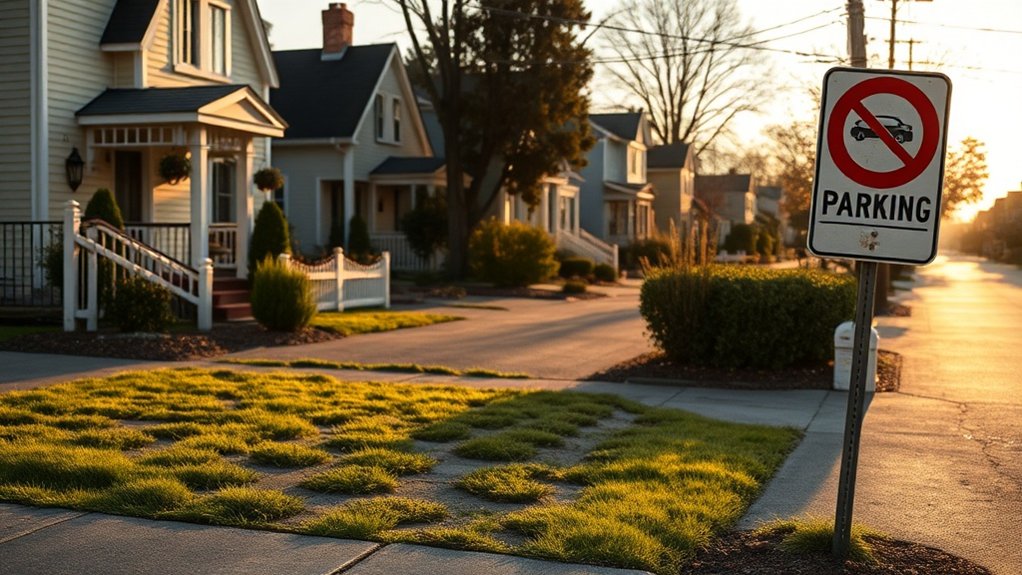
Local restrictions significantly impact your chances of obtaining driveway permissions, so it’s crucial for homeowners to understand these regulations.
Here are key points to consider:
- If your property is in a conservation area, you’ll likely need full planning permission for any changes to your driveway.
- Article 4 Directions may remove your automatic right to make certain changes, requiring express permission instead.
- Environmental factors, such as nearby wildlife corridors or protected trees, may necessitate an ecological assessment.
- In areas prone to flooding, your drainage solutions must meet local standards.
Ignoring these considerations can lead to enforcement actions or denial of retrospective planning permission.
Always consult your local council to ensure compliance and avoid costly errors.
Frequently Asked Questions
Can I Still Use My Driveway While Awaiting Retrospective Approval?
You can usually use your driveway while waiting for retrospective approval, but this can vary based on local planning regulations. It’s important to ensure your use complies with any specific guidelines to avoid enforcement action from your local council. For example, if your driveway has been altered without permission, it might be wise to check if you’re allowed to park there until you receive a decision.
What Costs Are Associated With Applying for Retrospective Planning Permission?
Applying for retrospective planning permission can incur various costs. The application fees typically range from £200 to £500. Additionally, you might need to budget for legal advice and consultancy fees if your case is complex. It’s important to note that failing to comply with planning regulations can lead to further expenses, such as fines or the cost of modifying or removing unauthorised work. Therefore, it’s wise to plan your budget carefully before proceeding.
How Long Does the Retrospective Planning Permission Process Typically Take?
The retrospective planning permission process usually takes about 56 days. However, factors like the complexity of the case, the workload of the local authority, community objections, and environmental considerations can all affect this timeline, potentially making it longer. For instance, if a property has been modified in a controversial way, it may attract more objections, leading to delays.
Will Neighbors’ Opinions Affect My Retrospective Application Outcome?
Yes, neighbours’ opinions can significantly influence the outcome of your retrospective application. Their concerns regarding the impact on the community and local issues may result in closer scrutiny of your case. For example, if they raise objections about noise or parking problems, it could hinder your chances of approval. Tackling these concerns early on can improve your likelihood of success.
Can I Appeal if My Retrospective Application Is Refused?
Yes, you can appeal if your retrospective application is refused. Interestingly, about 30% of appeals are successful. To enhance your chances, it’s crucial to directly address the reasons for refusal during the appeal process. For instance, if your application was rejected due to insufficient evidence, ensure you provide additional documentation that clearly supports your case.
Conclusion
Yes, you can apply for retrospective planning permission for a driveway, but it can be quite tricky. You’ll need to be aware of local regulations and gather solid evidence to support your case. Think of it like trying to turn a problem into a solution—it’s challenging, but doable. To save yourself the hassle of a retrospective application, it’s best to check local requirements before starting any driveway work. Prevention is key.
How can a tarmac driveway enhance your home's appeal? Discover the key aspects of cost, installation, and maintenance in our Read more
Not sure if you can lay tarmac over your existing driveway? Discover the crucial steps and benefits you need to Read more
Know the essential steps to secure planning permission for your tarmac driveway—discover key insights that could save you time and Read more


